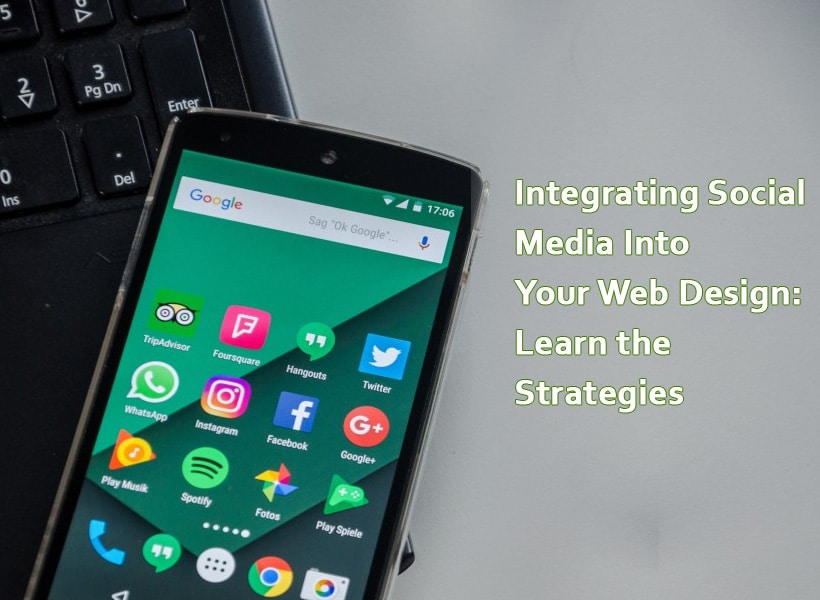Integrating Social Media Into Your Web Design: Learn the Strategies

In today’s digital age, social media is a tool for businesses to connect with their audience, enhance their brand presence, and drive website traffic. Integrating social media platforms into web design is not just a design element but a sure-fire way to get more visitors to your website.
To build an effective website design, learning how social media can be a real game changer for your website aesthetics and functionality is essential.
In this post, we will explore effective strategies for easily using social media in your web design. These methods will ensure a logical and engaging user experience that boosts your online presence and has visitors interact with your website.
Understanding the Importance of Social Media Integration
Before diving into the strategies, let us first teach you why it matters. The benefits can be manifold when you add links to the brand’s social media accounts to your website. From enhancing user engagement, improving your site’s SEO to extending your brand’s reach, using social media in website design offers a way for visitors to connect with your brand on various platforms.
When an audience lands on your social media accounts, they can share more content, potentially increasing your audience and driving more traffic to your site.
Strategies for Effective Social Media Integration
-
Social Media Icons: Simple yet Effective
Including social media icons is the most straightforward approach to adding social media to your website. These icons should be placed right in the face of your website — typically in the header, footer, or sidebar — and linked directly to your social media profiles. Ensure these icons are easily recognisable and consistent with your overall web design for the best user experience.
-
Social Login: Streamlining User Experience
Implement social login options and help visitors to sign up or log in using their existing social media accounts. This not only simplifies the login process but also encourages user engagement and registration. When integrating social login, prioritise the most popular platforms among your target audience to ensure maximum effectiveness.
-
Social Feeds: Keeping Content Fresh
Using social media feeds directly into your web design can keep your content fresh and dynamic. Displaying the latest updates from your Twitter feed, Instagram photos, or Facebook posts can provide lively content that encourages visitors to stay longer and engage with your brand.
It’s a fantastic way to showcase your brand’s personality and update your audience with the latest news or products.
-
Share Buttons: Sharing Promotes Brand
Embedding social share buttons on your website’s content — blog posts, product pages, or videos — makes it effortless for visitors to share your content on their social media profiles. This not only enhances the user experience but also amplifies your content’s reach and visibility across social platforms.
Ensure these buttons are visible and accessible every time to get the most benefits out of this strategy.
-
Social Proof: Leveraging User-Generated Content
Merging user-generated content (UGC) from social media can be powerful social proof, enhancing your brand’s credibility and trustworthiness. Featuring customer reviews, testimonials, or user posts about your products or services can influence potential customers’ purchase decisions.
Tools and plugins that curate and display UGC can automate this process, ensuring your web design always showcases the latest and most positive social proof.
-
Social Media Widgets: Interactive and Engaging
Adding social media widgets, such as a Facebook Like box or a Twitter follow button, can increase your social media presence directly from your website. These widgets promote your social media profiles and allow users to interact with your social content without leaving your site.
Social media interaction within your website can significantly boost engagement and follower count.
Best Practices for Social Media Integration
While integrating social media into your web design, keep the following best practices in mind to ensure optimal performance and user experience:
-
Keep It Consistent:
Ensure your social media icons, buttons, and widgets have the same colours and design and are easily accessible to your website’s design and branding. This consistency strengthens the brand identity of your web design and provides a solid user experience.
-
Prioritise Less but Meaningful Social Media Elements:
Ensure your social media integration does not compromise the website’s navigation. Social elements should enhance the user experience, not detract from it. Avoid overloading your site with too many widgets or buttons, leading to clutter and confusion.
-
Mobile Optimisation:
With the increasing use of mobile devices, ensure all social media integrations are optimised for mobile users. This includes responsive social share buttons, easily accessible social media icons, and mobile-friendly social feeds.
-
Monitor Performance:
Regularly monitor the performance of your social media integration efforts. Use analytics to track how these integrations affect traffic, engagement, and conversion rates. Adjust your strategy based on these insights to ensure the best website and social media presence outcomes.
Takeaway
Integrating social media platforms into your website design is not just about adding social icons to your homepage; it’s about creating a memorable and interactive experience that bridges the gap between your website and your social media presence.
Following the strategies outlined in this guide, you can enhance user engagement, increase your brand’s reach, and ensure a cohesive online presence that resonates with your audience.
Remember, the key to successful integration lies in consistency, usability, and ongoing optimisation based on performance insights. Make My Website a digital marketing company can make your website enlarge your social media impact, driving both engagement and conversions.

